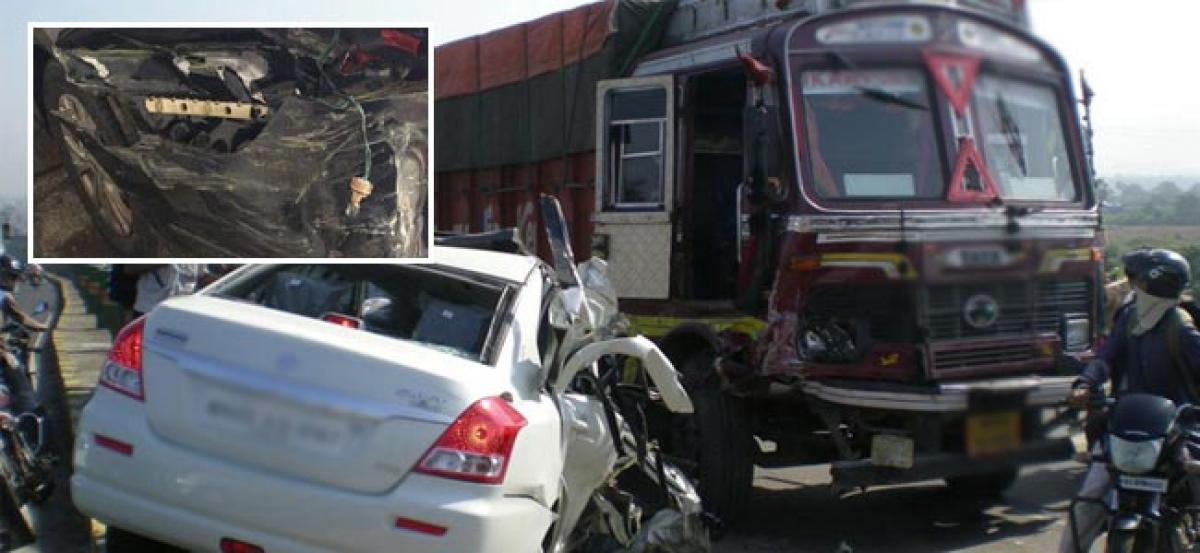Live
- Former Principal of SPW College passes away in US
- Hyderabad: Govt out to remove electric poles, transformers on roads across city
- KCR goes into huddle with State legal eagles
- Formula E race: KTR to be arrested soon?
- Film fraternity stands with Allu Arjun
- New CUAP campus faces security challenges
- HC grants protection to Allu Arjun from arrest
- Stampede victim’s husband ready to withdraw case against Allu Arjun
- Tomatoes price falls drastically to Rs 1 per kg at Pathikonda agri market
- Police clarify on Sandhya Theatre mgmt’s letter, deny allegations of misbehaving with Allu Arjun
Just In

More than 20,000 people lost their lives in hit-and-run cases nationwide in 2015, according to government data, and the reluctance of witnesses to be involved because of legal entanglements illustrates the need for clear laws to support “good samaritans”, as the state describes them.
More than 20,000 people lost their lives in hit-and-run cases nationwide in 2015, according to government data, and the reluctance of witnesses to be involved because of legal entanglements illustrates the need for clear laws to support “good samaritans”, as the state describes them.
Hit-and-run cases accounted for 11.4 per cent of total accidents in 2015, an increase from 10.9 per cent in 2014, according to road transport ministry data.
While 57 accidents were reported and 17 lives lost per hour in 2015, more than 54 per cent killed were between 15 and 35 years old, in the prime of youth.
Protecting Samaritans
On January 21, 2016, the government issued standard operating procedures to prevent unjust examination of eyewitnesses to road accidents, India's transport minister said, replying to a question by G. Hari, a Lok Sabha member Tamil Nadu, on February 25, 2016.
The standard procedures call for non-coercive, non-discriminatory, and time-bound inquiry into an accident -- and the examinee cannot be compelled to disclose personal information.
The guidelines also state that the samaritan does not have to pay for treatment unless he/she is related to the injured person.
National highways see more accidents
The central government intends to convert 52,000 km of state highways into national highways. The upgrade -- without instituting adequate safety measures on and along the national highways -- would be undesirable because the accidents and deaths in 2015 on national highways exceeded those on the state highways in 2014, by 4.5 and six percentage points.
Two-wheelers were involved in more fatal accidents (26 per cent) than other vehicles; those riding two-wheelers accounted for 25.2 per cent of all deaths on the road.
Uttar Pradesh (as on June 23, 2016) became the latest state to make wearing of helmets for pillions mandatory.
Controlled areas (manned by policemen or with machines installed for regulating traffic movement) witness fewer accidents (32 per cent of the total) as compared to uncontrolled environments.
More than 20 per cent of accidents were caused by drivers either on learner's licence or without licence, suggesting the need for remedial classes for those who cause accidents while on such licences.
As many as 52 per cent of 387 drivers tested to discern a causal link between visual defects and accidents failed in at least one of the vision parameters tested, according to a study by Ashish Varma, Assistant Professor, Transportation Engineering, Indian Institute of Science.
The study also found that 60 per cent of commercial bus drivers failed the minimum vision requirements for driving.
As many as 74 per cent of respondents expressed unwillingness to assist victims of road accidents, according to a study, Impediments to Bystander Care in India, conducted by SaveLIFE Foundation, an advocacy working for road safety and TNS India, a global marketing research company, in July 2013.
As many as 88 per cent of the unwilling bystanders cited legal hassles, involving repeated police questioning and multiple court appearances, for their hesitation.
Nearly 90 percent of the study participants wanted the enactment of a law to protect bystanders from harassment in case of administration of help to the victims.
The SaveLife-TNS study also points to another study by the Indian Journal of Surgery published in 2006 where it was found that 80 per cent of road accident victims do not receive any medical care within the first or golden hour after the accident.
The absence of any protective framework is in stark contrast to legislations prevalent throughout the world.
The 201st Law Commission report mentions that doctors say 50 per cent of accident victims could be saved if timely intervention is ensured.
Global pledges and comparisons
The Sustainable Development Goals (SDGs) formulated by the United Nations on September 25, 2015 aim to halve the global deaths and injuries from road accidents by 2030.
For India (a middle-income economy), the target is less than seven fatalities per 100,000 population from a baseline of 20.1 in 2010.
India became a signatory to the Brasilia declaration on November 19, 2015, committing to halve road accident deaths by 2020.
The road ahead: mitigating measures
A pilot project for cashless treatment of road accident victims is already operational on NH-8 (Gurgaon-Jaipur and Vadodara-Mumbai) and NH-33 (Ranchi-Mahulia). The service includes free cashless treatment up to Rs 30,000 for road accident victims within 48 hours.
The government is also implementing the National Highway Accident Relief Service Scheme (NHARSS) to provide cranes and ambulances for evacuation purposes. As many as 140 advanced life support ambulances have been handed over to 140 identified state government hospitals.
By Rahul Mohan Sharma
(In arrangement with IndiaSpend.org, a data-driven, non-profit, public interest journalism platform. Rahul Mohan Sharma was a Legislative Assistant to Member of Parliament (LAMP) fellow for 2015-16, assisting a senior Rajya Sabha member on policy matters.The author can be reached at [email protected])

© 2024 Hyderabad Media House Limited/The Hans India. All rights reserved. Powered by hocalwire.com







